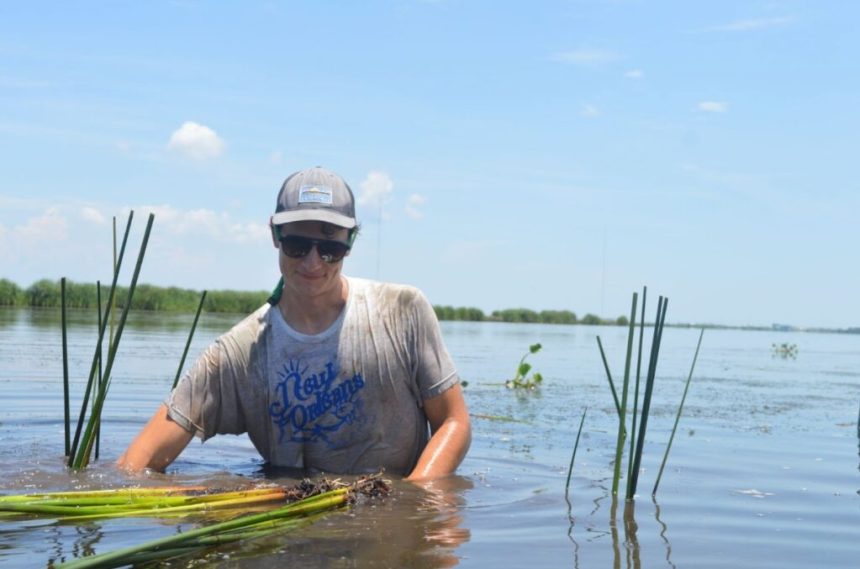A volunteer with the Central Wetlands Reforestation Collective plants bullrushes in the Bayou Bienvenue swamp. (Photo by Lue Palmer for Louisiana Illuminator)
This reporting is supported by the Pulitzer Center. an essential source of support for enterprise reporting in the United States and across the globe.
NEW ORLEANS – The boat at the docks of Bayou Bienvenue was loaded with stacks of green bullrushes. Its passengers — three local coastal restoration experts, two young scientists and a few stalwart volunteers with the Central Wetlands Reforestation Collective — prepared to climb waist deep in the muddied soil of the bayou, home to alligators, snakes and wild hogs. Beyond the rumble of the airboat, white egrets and the quick flash of a rare pink spoonbill could be seen flying over the narrow islands.
Jimmie Price, an environmental scientist and 25-year-old New Orleans native, sat at the front of the boat, carefully answering questions about the planting work to be done. With practiced deftness, the team docked at a narrow island, leapt onto the banks and tossed bundles of bullrushes, fireman-style, onto the narrow strip of land.
In what was once a richly forested area, there are now only a few wavering trees. Cypress and native grasses that were one of the region’s greatest defenses against hurricanes have been decimated in areas by canals and trade routes, leaving the bayou vulnerable to salt intrusion and storm surge.
Amid more frequent and increasingly intense climate threats, local groups are attempting to restore the region’s shifting land and depleted hurricane buffer. But while funding for coastal restoration is dwindling, local residents stress that this work is not just for South Louisiana.
“The Gulf is 10 miles closer to Baton Rouge. It’s 10 miles closer to Chicago, frankly,” James Karst, communications director for the Coalition to Restore Coastal Louisiana, said of the region’s escalating land loss and extreme weather. “These are things that are impacting all of us, or at least they will. I hope that people will recognize that. ”
SUBSCRIBE: GET THE MORNING HEADLINES DELIVERED TO YOUR INBOX
‘Disadvantages to future generations’
The Mississippi River Delta is home to millions of acres of wetland. One of the most important river systems in the world, it provides essential migration habitat for bird and fish populations, as well as a vital trade route for much of the United States. For thousands of years, cypress trees, native grasses and natural sediment distribution have helped prevent the land in the lower delta from disappearing into the sea.
Over the past century, engineers have attempted to control the natural system, levying the Mississippi on all sides. But experts have also warned that consequences would be felt in the future.
Over a hundred years ago, noted engineer E.L. Corthell advised that levying the river would bring about so much subsidence that it would cause the “gradual abandonment” of the lower delta.
“The present generation should not be selfish,” Corthell wrote in a December 1897 issue of National Geographic. “Yet it is safe to say that the development of the delta country during the twentieth century by a fully protective levee system, at whatever cost … will be so remarkable that people of the whole United States can well afford, when the time comes, to build a protective levee against the Gulf waters.”
Indeed, efforts to engineer the Mississippi continued throughout the 20th century, putting significant stress on the lower river basin. Perhaps most notable, in 1956, Congress approved the Mississippi River Gulf Outlet, known colloquially as Mister GO, a channel that linked the Industrial Canal and the Gulf.
Designed to provide a quick route for shipping and defense, Mister GO opened the region to the intrusion of saltwater from the Gulf, devastating the freshwater cypress and native plant populations and depleting the natural hurricane buffer. The canal also created an inland path for high winds and storm surge, in what has been deemed a “hurricane highway,” leaving areas such as adjacent St. Bernard Parish and New Orleans’ Lower 9th Ward vulnerable to extreme damage.
On the heels of the three hurricanes that struck the region in 2005 — Cindy, Katrina and Rita — Louisiana’s Coastal Protection and Restoration Authority was formed to manage the changing coast into the future. It drew from decades of varied and creative plans, some as drastic as abandoning the most southerly parts of the delta entirely.
But there was a key shift in managing issues such as salt water intrusion from building levees to offensive strategy, said Denise Reed, coastal scientist with the University of New Orleans and an adviser to CPRA.
“We go from this way of trying to hold the line and build levees and walls to managing marshes and managing hydrology,” Reed said.
In its 20 years, the CPRA has strengthened roughly 350 miles of levees and restored 60 miles of barrier islands and headlands, according to its most recent master plan. But perhaps its most promising intervention, the Mid-Barataria Sediment Diversion, which was expected to restore 21 square miles of new land over the next 50 years, has been cancelled.
With state efforts on unsteady ground, planters wade out into Bayou Bienvenue with their stacks of wild grasses and infant trees.
‘What we’re planting, those are the first responders’
The Central Wetlands Reforestation Collective team grasped the bulbous roots of the bullrushes and pushed them deep into the mud of Bayou Bienvenue. If all goes well, the new plants will spread around the barrier islands, protecting the fragile shores. But summer heat in Louisiana is scorching, and the water is hot and thick with nutria droppings, an invasive rodent species that feeds on juvenile cypress trees.
While the threat to the vulnerable plant life is formidable, the group of planters also manage their own risks. An alligator made its way around the barrier island to where the team’s coastal restoration coordinator, Arlo Townsley, was waist deep in mud. He extricated himself calmly and made his way to shore.
Volunteers with the Central Wetlands Reforestation Collective load saplings onto a boat to be planted into the Bayou Bienvenu swamp. (Photo by Lue Palmer/Louisiana Illuminator)
Over the next year, their aim is to finish planting a total of 63,000 trees. Hardy plants such as tupelo, cypress, buttonbush shrubs and lead plants are also important to the healthy ecology of Louisiana’s wetlands. Several have been harvested by the team from native species in the delta and then grown in nurseries across New Orleans.
The importance of replanting the region cannot be understated, Price said.
“Those trees, those organisms, those marsh grasses, they act first,” he said, referring to the role of native plants in preventing coastal erosion and protecting the region from extreme weather.
Hurricane season 2025 was projected to be a very active one for Louisiana, with 17 named storms predicted, four of which were forecast to develop into major hurricanes. As of Sept. 30, there have been no major storms or impacts along the Gulf Coast, but Price knows a quiet season is never guaranteed.
“What we’re planting, those are the first responders,” he said.
Over the past four years, Price has worked with the Lower 9th Ward Center for Sustainable Engagement and Development, helping teach young New-Orleanians about the region’s hydrological system and how to participate in restoring it.
While engaging local residents in the fate of the coast is important, Reed said, these projects might have a limited environmental impact.
“It’s just not enough,” the UNO professor said. “How many millions of projects do we need like that to actually make a difference?”
Limited sediment and money
There is a complex network of collaborating state and federal bodies working to restore Louisiana’s coast. The National Oceanic Atmospheric Administration has rebuilt approximately 12,500 acres of coastline through the Coastal Wetlands Planning, Protection and Restoration Act, which Congress enacted in 1990 to pay for the design and construction of coastal wetlands restoration projects.
One of the most important sources of funding for coastal restoration in Louisiana over the past decade is winding to a close. In 2010, the BP Deepwater Horizon oil spill, considered to be one of the worst environmental disasters in U.S. history, released 4 million barrels of oil into the Gulf, decimating oyster, dolphin and sea bird populations in the region and threatening local communities that depend on subsistence fishing.
Funds from the $5 billion settlement for the five Gulf Coast states, allocated in 2012, were the resource behind much of the CPRA’s other projects. Where comparable funding will come from for future coastal restoration is unclear.
“But that doesn’t mean to say we shouldn’t have all the ideas in hand,” Reed said. “It really did help us when Deepeater Horizon came along, that we had a plan ”
Short of an environmental disaster, energy revenues might be one avenue to increasing coastal restoration funding.
The Gulf of Mexico Energy Security Act, which U.S. Sen. Mary Landrieu steered through Congress in 2006, opened the Outer Continental Shelf in the Gulf of Mexico to an additional 8.3 million acres of offshore drilling. A portion of these exploration revenues go toward coastal restoration in Louisiana. Expanding the state’s revenue percentage might be a viable option for bringing additional revenues to the region, Reed said.
Restoring the delta is also a question of national responsibility, she continued.
“The Mississippi is clearly a national resource and a national asset, and clearly the levees along the river have contributed to the issue,” Reed said, arguing that the federal government should have a role in restoring the delta.
Who should bear the cost and responsibility to save Louisiana’s coast is also a battle over priorities. With limited sediment and funding, planners might have to make tough calls about which part of the lower Mississippi River Delta can realistically be restored — and which parts could be yielded to the sea.
“You only have so much sediment, you only have so much money,” said Clint Wilson, dean of Louisiana State University’s College of the Coast and Environment.
For Wilson and other engineers, maintaining the lowermost reaches of the delta, especially the final 30 miles, may no longer be practical. The question, he said, is one of economics.
“The communities are getting smaller. Then what’s the economic driver for spending hundreds of millions of dollars to maintain the river?” he said, arguing for a need to prioritize trade routes and, to some extent, the petrochemical industry in South Louisiana.

Jimmie Price, an environmental scientist and 25-year-old New Orleans native, is part of the Central Wetlands Reforestation Collective that is working to rebuild the wetlands loss to the Mississippi River Gulf Outlet. (Photo by Lue Palmer for Louisiana Illuminator)
‘We don’t deserve to be protected?’
The question of what is prioritized could be far more personal for residents living in the lower delta.
“We’re a part of this country too. And so why should you overlook us for industry. We don’t deserve to be protected?” said the Rev. Tyronne Edwards of the Zion Travellers Missionary Baptist Church.
Edwards says his family has lived in the lower delta “before it became Plaquemines Parish.” It was once a hub of sugarcane plantations, where thousands of people were enslaved in service of one of Louisiana’s most profitable exports.
Edwards’ ancestors were among those whose labor helped to build the area and who later came to settle in Phoenix, a small town on the east bank of the Mississippi River, about 30 miles south of New Orleans Lower 9th Ward.
The residents of Phoenix have long fought for their voices to be heard, Edwards said, organizing for civil rights and against voter suppression. Today, he says the east bank floods frequently during heavy rains and storm surge. Unable to rebuild and elevate their houses, restoring and protecting the coast is essential to their community’s future, according to the pastor.
Additional land barriers and mangrove replanting are two of the solutions Edwards, also a Plaquemines Parish councilman, said he hopes to see. For the past decade, he has been a regular attendee at CPRA meetings but has been unsatisfied with its response to community feedback, he said.
The CPRA 2023 Master Plan included the Mid-Breton Sediment Diversion on the Plaquemines east bank, at nearby Will’s Point. Like the cancelled Mid-Barrataria Sediment Diversion upriver on the west bank, its aim is to build new wetlands by restoring the natural process of the Mississippi River.
The CPRA did not respond in time for publication regarding the status of the Mid-Breton Diversion and whether it would be included in the forthcoming 2029 Master Plan, which is currently accepting public input.
“I’m really frightened about the state of coastal restoration because it seems like we have abandoned it,“ Edwards said. “The East Bank to me is like the bastard child, the forgotten people, when it comes to coastal restoration.”









